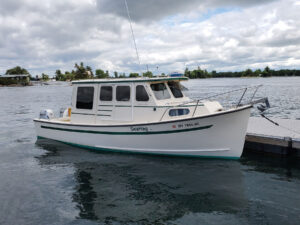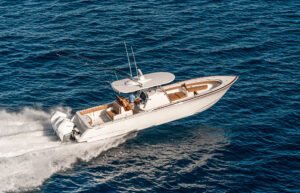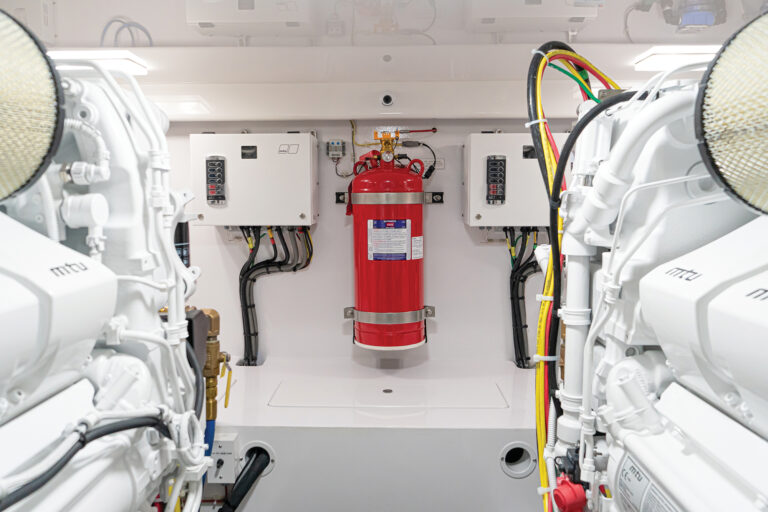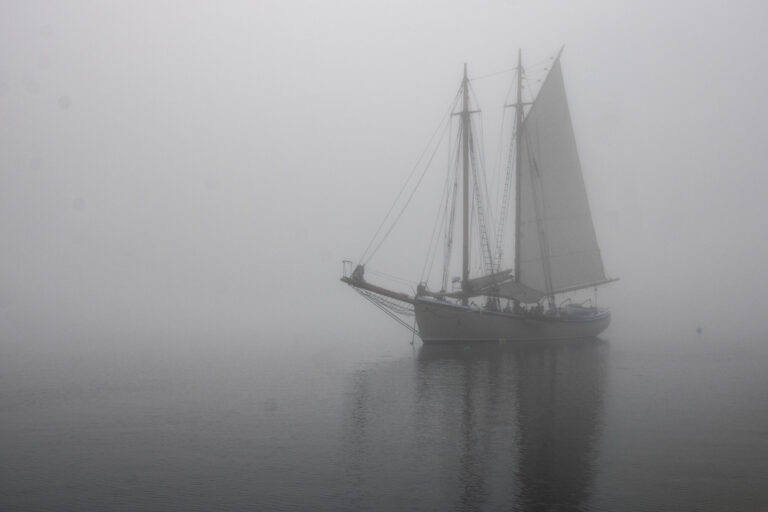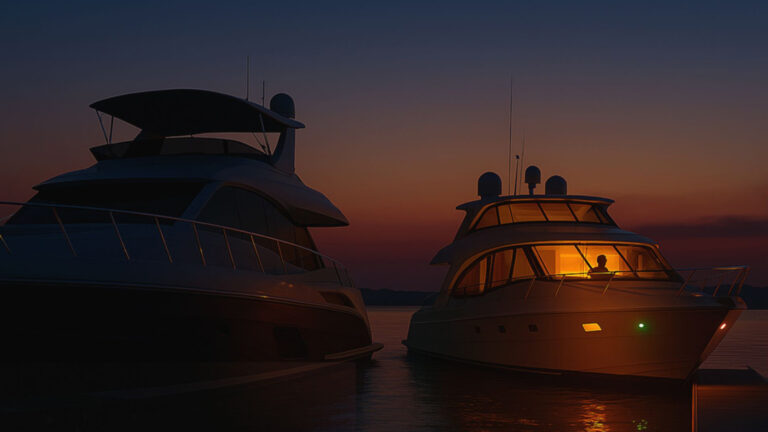Boating is, without question, one of the finest family activities around. Although we can all extol its many joys and benefits, we must acknowledge that there are a few negatives.

One of the biggest, keeping thousands of would-be boating enthusiasts ashore, is seasickness. This affliction is caused primarily by the side-to-side rolling that comes from interactions between a boat’s hull and the sea. If that rolling can be mitigated, the incidence of mal de mer is reduced, and everyone is a lot happier and healthier.
Larger yachts, as well as smaller yachts of moderate speed, have had a number of choices in roll control over the years. Bilge keels and paravanes (flopper stoppers) are often employed on long-range, displacement-hulled cruising boats. Active systems, using either fins or rotors, are common on larger yachts. Whether operating at displacement or semiplaning speeds, these larger vessels have both the space and power to allow for such systems.
Smaller faster boats, however, are seldom stabilized by anything other than their own hard-chine hull forms. That is usually acceptable at planing speeds, where the dynamic forces are large enough to counteract rolling, to some extent. But when dead in the water — at anchor or drifting while fishing, for instance — it’s another matter entirely. This unhappy situation has been accepted not by choice but by necessity. Simply put, we came to believe that there were no good solutions. Anything external to the hull, such as fins or keels, created drag that reduced speed and increased fuel consumption to unacceptable levels.
When money was no object, sophisticated systems using innovative solutions, such as folding or retractable fins, were tried on big yachts, but how many of us own both a super-sportfisherman and a bank? What was needed was a stabilization solution for the masses, the huge center of the boating bell curve, for those who wanted a better ride without busting their budget.
The answer, surprisingly, is a “new idea” that has been around for decades: a gyro. Unless you’re in a boating frame of mind, a gyro sounds like a Greek sandwich, but on board, the name is shorthand for gyroscopic stabilization, a system that is suitable for boats of nearly all sizes and types. Gyros are essentially wheels that spin at extremely high speed inside an airtight case that’s bolted securely to the hull structure — a big daddy to the familiar childhood toy of the same name. The same inertial force that keeps the spinning toy magically sitting on a stand or string keeps the boat on course and on the level.
The heavier the wheel and the faster it spins, the more stabilizing force is developed. The wheels are massive metal castings, and rotational speeds are in the many thousands of revolutions per minute. To stabilize the boat, the units impart tremendous force into the boat’s structure. This means gyros must have a substantial foundation capable of taking the cyclical loads repeatedly without cracking or tearing loose from the hull. (The same, of course, is true of active fin stabilizers and paravanes.)
Gyros were somewhat common on cruise ships and the largest yachts in the early to mid-20th century, but they fell out of favor due to problems with both the materials that were used to cast the heavy wheels and with the bearings in which those wheels were mounted. About the same time, hydraulic power began replacing steam in the heavy-equipment industry. This, in turn, enabled the development of all sorts of hydraulically powered equipment for boats, as well, including active fin stabilizer systems. They soon displaced the bulky and temperamental gyros of that era, which were quickly forgotten.
Only in the past 10 years or so have gyros once again found favor, thanks in part to advances in materials and technology that addressed the earlier problems, and in part to a desire for stabilization aboard boats not well suited to other systems. The first gyro units of the modern era were for midsize yachts, a strategy to save on development costs by hitting the heart of the market. Many more choices have since been added, both larger and smaller. This means that if you have anything larger than a runabout and smaller than an aircraft carrier, there’s probably a gyro system that’s right for you.

Gyros offer a couple of interesting aspects of flexibility that are not found in some of the other stabilization systems. It is not necessary to mount one massive gyro at a central, dedicated and preplanned location aboard your boat. Multiple smaller units can be used to achieve the desired level of stabilization. In addition, gyros can be mounted virtually anywhere they can be secured to the vessel’s structure. They need not be mounted on centerline or symmetrically to either side, and their longitudinal location is also flexible. This is especially handy in retrofit situations, whether replacing another system or installing stabilization for the first time in an existing boat.
One point of possible confusion should be mentioned here. Some stabilizer manufacturers refer to their units as gyro-controlled. This means that the control box contains a small internal gyro to sense movement and generate signals to control active fin or rotor systems.
To my knowledge, there are only three major manufacturers of true gyro stabilizers: Mitsubishi (antirollinggyro.com), Seakeeper (seakeeper.com) and Veem (veemgyro.com). Veem units are manufactured in Australia, primarily for superyachts and ships. Both Mitsubishi, built in Japan and supplied exclusively in the United States by American Spindoctors, and Seakeeper, built and sold factory-direct in the United States, offer a broader range of units, including gyros for smaller boats. The smallest units — the Mitsubishi ARG125T and the Seakeeper 3DC — are rated for boats in the 10-ton (displacement) range, nominally 30 feet or so. The 3DC, introduced this spring, is a direct-current unit suitable for boats without generators, or for owners who wish to run off battery power at anchor or while fishing without an inverter. They start at less than $30,000, though installation will certainly up that figure. The cost of larger units — more than 10 times the capacity of the smallest ones — climb well into six figures.
When I spoke to sales managers Rick Olsen at Spindoctors and Maggie Meredith at Seakeeper, they were enthusiastic about their prospects for the future, as gyros are gaining favor with boatbuilders and owners alike. New models are in development at both companies, but they did not share the details for publication.
Although they were quick to point out the advantages of their units over others, the independent feedback I’ve gotten from the field indicates you can’t go too far wrong with either brand. The real mistake would be postponing or canceling a trip aboard your boat because you fear it would be uncomfortable. Life is short; a gyro can help you add to your time at sea.
This article originally appeared in the July 2015 issue.



